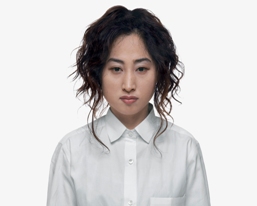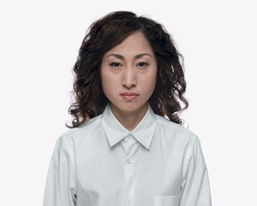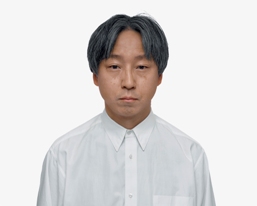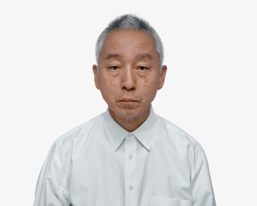The Pure Self
Fourteen photographs, three faces. Walking into Kitajima’s latest exhibition, one is greeted by what first appears to be an uncanny collection of doppelgangers; all super-imposed against the unblemished white background, all from the same angle, wearing the same white shirt, the same expression, the same gaze. In order to steady oneself, the viewer is invited to play a childish game of spot-the-difference, scrutinizing the tell-tale wrinkles, the white shirt, the miniscule variations in expression. One realises there is a time lapse of several years between each portrait, but as the spatial positioning of the models from the lens is maintained precisely, it feels as if one is encountering several versions of the same self.
Kitajima took pains to select models that he did not know, and made no attempt to develop a personal relationship with them, despite meeting with them several times over a few years. While his biological subjects age, the quality of the print or style of presentation do not. They wear exactly the same expression in each shot, varying from person to person: slight discomfort, resignation, even a glower of contempt. Yet apart from this, nothing is revealed about the models themselves. Bereft of introduction or biography, their social position blanked out by the identikit white shirts, they are stripped down to a pure self that continues regardless of – or detached from – their social relations.


The lack of acquaintance between the subjects and the photographer has been a common theme throughout Kitajima’s career. However, his reputation was built on a vastly different body of work that embodied the ‘snapshot’ aesthetic so beloved of Japan’s photographic giants; Nobuyoshi Araki, Daido Moriyama, and Takuma Nakahira. Employing their spontaneous, shot-from-the-hip style, he covered Japan (both Tokyo and Koza, an American mili-tary hub in Okinawa), New York, the USSR and Eastern Europe, chronicling the bizarre and licentious flavour of their underground scenes, complete with crime, nudity, glamour and booze.
Yet in 1991 he rejected the instantaneous recording of a chaotic and sleazy nightlife, and began to develop a more staged and technical style. Turning his back on a photography that imposed its judgmental gaze on subjects without their consent, Kitajima decided to begin experimenting with a more controlled method, removing the background context and allowing subjects to speak for themselves. Ironically, stripped of any meaningful context, those displayed in “Portraits” hardly seem to speak at all. The fact that their blank, moody, and even defiant expressions cannot be indicative of their personality in general suggests that Kitajima is rather commenting on the nature of portraiture, and confirming the notion that ‘the gaze’ is an imposition that subjectivises and does violence to its object.


His work here is not only interesting because of the way in which it captures the continuity of self through the biological aging process, but also because it marks a move away from the rapid-fire documentation of the photographer’s surroundings so characteristic of recent Japanese photography. In contrast to that trend, Kitajima’s photographs are surprising not because of their context and illicit flavour, but rather for their lack of it. With the context erased, we are confronted with nothing but the unsettling, pure self.
Sophie Knight
Sophie Knight



